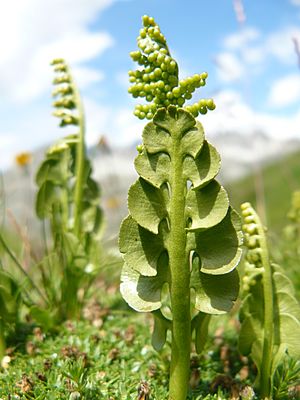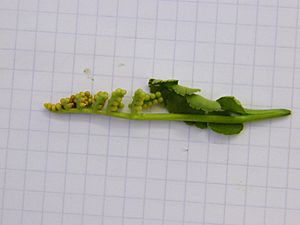Common moonwort facts for kids
Quick facts for kids Common moonwort |
|
|---|---|
 |
|
| Conservation status | |
| Scientific classification | |
| Genus: |
Botrychium
|
| Species: |
lunaria
|
| Synonyms | |
|
|
Botrychium lunaria is a type of fern often called the moonwort or common moonwort. It's the most common kind of moonwort fern. You can find it all over the Northern Hemisphere, like in Europe, Asia, and from Alaska to Greenland. It also grows in warmer parts of the Southern Hemisphere.
About the Moonwort Fern
This is a small plant that usually grows up to 30 centimeters (about 12 inches) tall. It grows from a part of its stem that stays underground. The leaf of the moonwort fern is divided into two main parts.
One part is the sterile frond. This part looks like a regular fern leaf. It has about 4 to 9 pairs of fan-shaped leaflets. These leaflets are called pinnae.
The other part is the fertile frond. This part looks very different. It has round, grape-like clusters. These clusters are called sporangia. They produce tiny spores, which are like seeds for ferns. This is how the moonwort fern makes new plants.
Like other ferns in its family, the moonwort has special sporangia. These sporangia are thick-walled and grow from many cells. The spores from these sporangia grow into tiny, underground plant parts. These parts are called gametophytes. They get their food from fungi in the soil.
Moonworts often disappear at the end of summer. They can stay hidden underground for several years. Then, they might pop up again when conditions are right.
Where Moonworts Grow
Moonworts are found all around the world. They grow in many places in Europe, Asia, and North America. You can also find them in Greenland. They even live in North Africa, the Himalayas, and warmer areas like Australia, Tasmania, New Zealand, and South America.
Even though they are spread out, they can be rare in some local areas. The good news is that the moonwort is not considered an endangered plant. It is listed as "least concern" by the IUCN Red List. This means it's not currently at high risk of disappearing.
However, in some places like the British Isles, there are fewer moonworts than there used to be. For example, in Worcestershire, England, it was once found in seven different spots. Now, it seems to grow in only one place.
Moonwort's Home and Lifestyle
Botrychium lunaria likes to grow in places with short grass. These can be dry or slightly moist areas. You might find them in meadows, small woods, heaths, and moors. They often grow in higher areas. It's rare to find them in dense forests.
This fern can also grow in places where the land has been changed by humans. These are called brownfield sites. This includes places like old mining waste piles or shale heaps. This is especially true in central Scotland.
Moonworts prefer soils that are not too acidic or too alkaline. They often grow where there is limestone or chalk. These soils are rich in lime. They can grow at very high altitudes, up to 2,500 meters (about 8,200 feet).
When they are young and even as adults, moonworts need help from fungi in the soil. This is called a mycorrhizal relationship. Because of this, they can be harmed if the soil is disturbed too much. They might also need rotting plant material in the soil to grow well.




